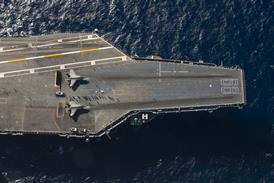Douglas Barrie and Simon Elliott/LONDON
THE BRITISH ARMY is considering the cancellation of a key unmanned-air-vehicle (UAV) programme which is six years behind schedule and has cost the Ministry of Defence (MoD) £227 million. Project costs have more than doubled, compared with the original estimates when the deal was signed with prime-contractor GEC-Marconi ten years ago.
A top-level MoD review into the future of the project is now under way. A decision on whether to abandon the programme is expected by the middle of the year.
The GEC-Marconi Phoenix UAV had been originally intended to enter service with the British Army in 1989 to provide critical real-time surveillance and target acquisition for Royal Artillery Multiple Launch Rocket Systems and AS90 self-propelled howitzers.
The Phoenix system was accepted by the British Army in 1994, but has still not gone into operational service.
The MoD has confirmed the investigation, saying: "The project is under review. There are various options, though nothing has been decided. The project is being reconsidered." MoD officials indicate that cancellation is a possibility.
GEC-Marconi refuses to discuss the programme, beyond claiming that it has "...no knowledge of any consideration by the customer to cancel the programme".
MoD officials are believed already to have begun looking at alternative UAVs, including widely exported Israeli-built systems.
The MoD Phoenix development has been dogged by technical problems with the vehicle, its payload and the ground-support equipment. The UAV was designed and built by UK subcontractor Flight Refuelling.
In evidence to a Parliamentary Defence Select committee in 1990, the MoD detailed difficulties. These included problems with the datalink, which could lead to loss of contact with the air vehicle; computer problems with the ground station; and recovery problems with the air vehicle. At least some of these problems still persist.
One GEC executive told Flight International that the system is known internally as the "Bugger Off - because often it doesn't come back once it is launched".
Five years after the report, the British Army is still having to rely on the ageing Canadair CL-89 surveillance drone which has to be recovered and film processed before targeting data are available. In the Gulf War, UK MLRS batteries frequently relied on targeting provided by US Marine Pioneer UAV systems.
Some sources also claim that there is concern over the Phoenix's payload. The Army looked at incorporating a more powerful powerplant in 1994, but this was abandoned on cost grounds. The new engine was said to be required to improve performance in hot-and-high conditions, such as in the Gulf. When the specification was originally issued in 1980, the UAV was intended for use in Central Europe.
GEC won the £80 million contract for development and production in 1985 with a novel approach of landing the vehicle upside down by parachute, with the impact to be taken by a shock-absorbing plastic hump.
Cancellation of the UAV would be a further blow to GEC-Marconi's credibility. The MoD abandoned the trouble-torn GEC-Marconi-led Nimrod Airborne Early Warning aircraft programme in the 1980s after spending more than £1 billion. The company was also heavily criticised throughout the 1980s for its role in other late and technically troubled programmes.
Source: Flight International























